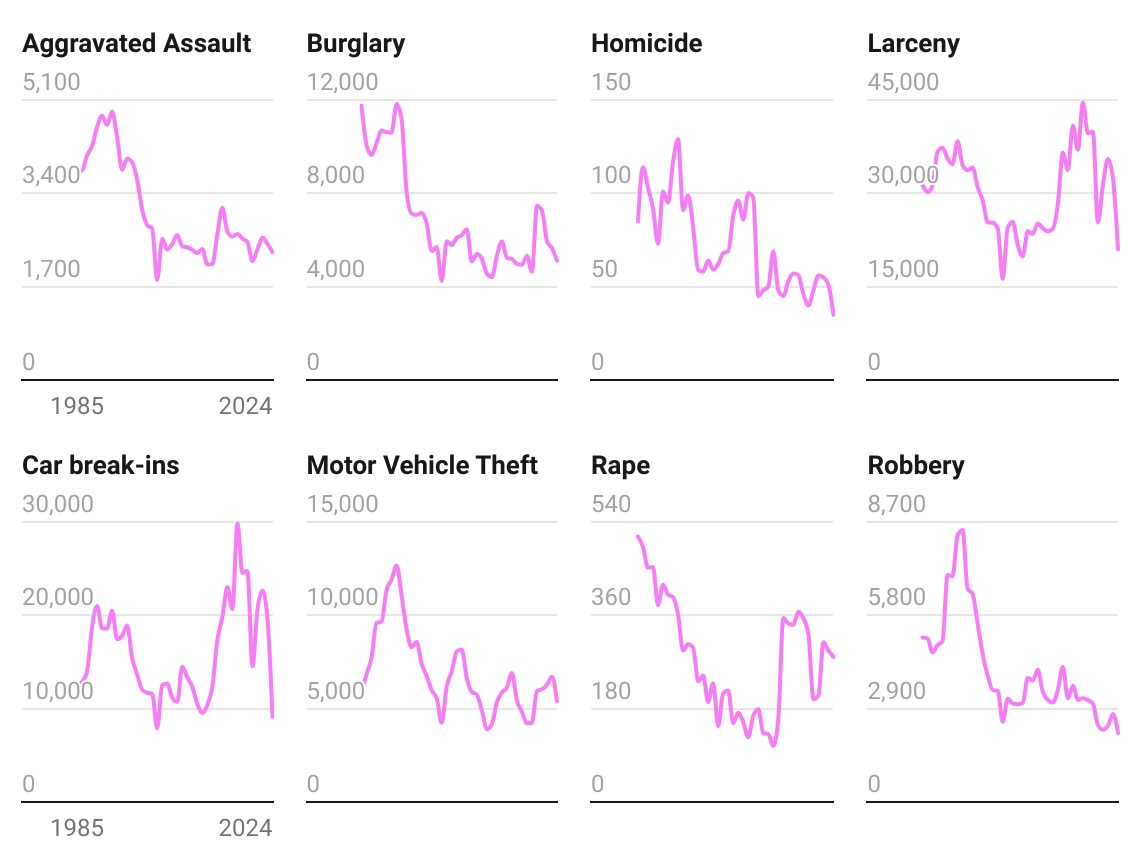As the threat of a federal crackdown in San Francisco looms, local politicians are rallying to assert that sending National Guard troops isn’t necessary.
And they have the data to back that up.
Both violent and property crime in San Francisco are at record lows and down between 29 and 41 percent since 2015. Homicides are at their lowest rate in 71 years, robberies and burglaries at their lowest in 40 years, and even car breaks are at their lowest in 20 years.
“Thanks to local law enforcement and city workers, San Francisco is one of the safest cities in the country,” said City Attorney David Chiu in a statement to Mission Local on Monday. “Crime is at its lowest point in decades. Our local law enforcement are more than capable of keeping our city safe.”
Chiu, Mayor Daniel Lurie, and other city officials have repeatedly pushed back against claims by President Donald Trump that San Francisco “went wrong.” “Look at what the Democrats have done to San Francisco. They’ve destroyed it,” said Trump on August 22, during a press conference.
This past weekend, Trump vowed to bring the National Guard to the city, and Chiu vowed to sue if he tried.
By many measures, crime in San Francisco is indeed at its lowest point in decades. According to data provided by the San Francisco Police Department, and data published by the California Department of Justice:
Homicides are on track to reach their lowest rate in 71 years. There were 22 homicides in San Francisco so far this year, and the last low was 27 homicides in 1954.
The number of robberies in San Francisco is on track to be the lowest since 1985. In 2025 so far, there were 1,354 robberies, that’s a 23 percent decrease compared to the same period last year. Likewise, burglaries are also on track to reach their lowest since 1985.
Motor vehicle theft (that’s the theft or attempted theft of a vehicle itself) has declined over the last two years, after a spike in 2023, when there were 6,704 reported incidents. So far this year, there have been 2,504 incidents. Historically, the rate of motor vehicle thefts was much higher, reaching over 12,000 incidents in the early 1990s.
Larceny, which includes shoplifting, pickpocketing and car break-ins, has declined since 2022, and is much lower than historic highs. Similarly, arson incidents have declined since 2021.
Aggravated assault has hovered around the same number over the last decade, but is also down from historic highs.
On Tuesday, the Council on Criminal Justice, a think tank, released a new report that found most crime categories in San Francisco down between 2019 and 2025. The exceptions: gun assaults, shoplifting, and drug offenses. That’s based on police incident reports, which log arrests and citations.
According to the report, drug offenses in San Francisco increased 114 percent, when comparing the first half of 2019 to the same period this year.
While that may reflect a spike in drug related incidents, Ernesto Lopez, a senior researcher at the Council on Criminal Justice, explained that it could also reflect more enforcement: If officers conduct more searches, he said that to some degree the increase in drug crime is “a function of police enforcement.”
When Mission Local analyzed police incident reports around the 16th St. BART station, for instance, a quarter of all drug arrests and citations in the city came from the intersection. Experts said that was likely due to more enforcement after the department stepped up patrols and visibility there in March.
Drug incidents aside, the trend in crime data in San Francisco reflects that of other cities across the United States — and those nearby. In Alameda County, which includes Berkeley, Oakland and Fremont, the number of crimes overall decreased by 32 percent between 2023 and 2024, according to data from the California Department of Justice.
According to Jeff Asher, a data analyst and consultant, violent crime nationally is down by 11 percent and property crime is down by 12 percent, when comparing the first five months of the year with the same period last year. “We’re seeing very large declines pretty much everywhere. For the majority of places: Crime is declining and is declining sharply,” said Asher.

